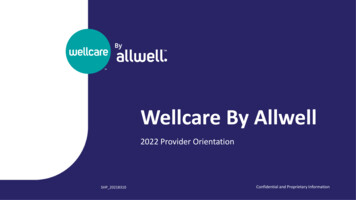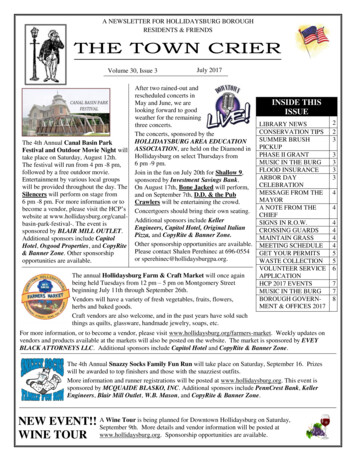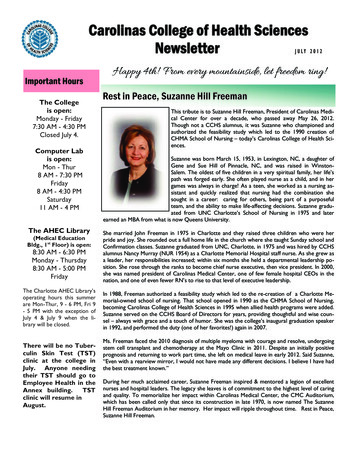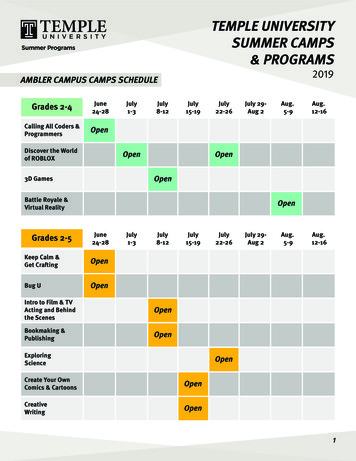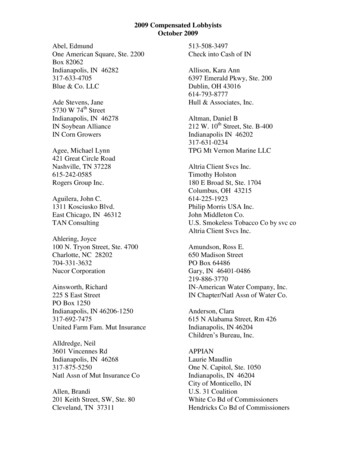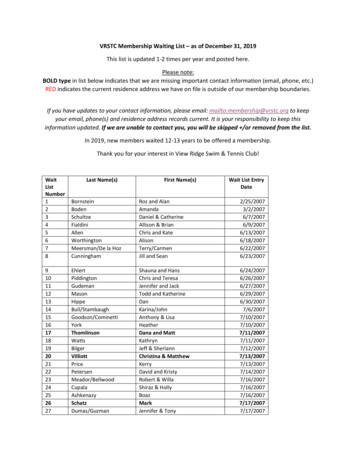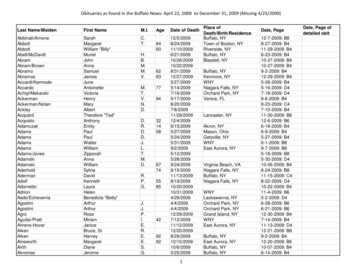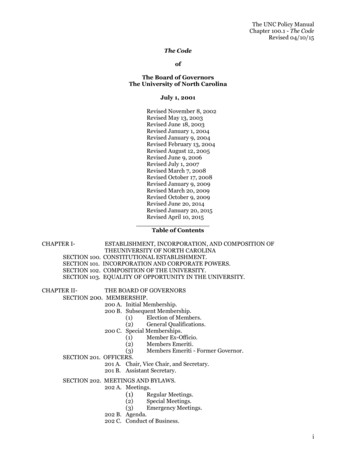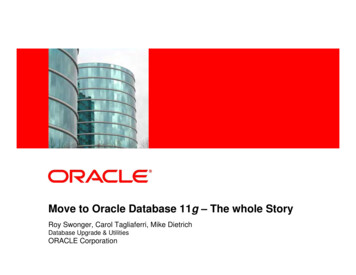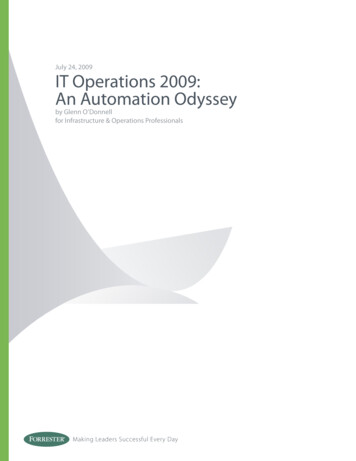
Transcription
July 24, 2009IT Operations 2009:An Automation Odysseyby Glenn O’Donnellfor Infrastructure & Operations ProfessionalsMaking Leaders Successful Every Day
For Infrastructure & Operations ProfessionalsJuly 24, 2009IT Operations 2009: An Automation OdysseyPrepare For The IT Automation Inflection Nowby Glenn O’Donnellwith Simon Yates, Ben Echols, Christian Kane, and Lauren NelsonExecuti v e S u m ma ryA combination of forces, including skyrocketing complexity and severe economic pressure, areradically and irreversibly altering the IT landscape. New methods, new functional sourcing, and neworganizational structures are needed to address this onslaught, but one theme is obvious throughout allof these approaches — a need to automate more of what you do in IT. The typical IT organization wastesa significant portion of its budget on inefficiencies that only get worse as complexity grows. Automatemany of these tasks and you become leaner and more responsive to business changes. Evidence indicatesan automation “tipping point” is already under way this year. All IT shops need to consider their plansfor automation, including the many derivative outcomes for process refinement, staffing, tools, and theorganization itself.ta bl e of Co n te nts2 Inefficiency Plagues IT OperationsPursue Automation For Efficiency AndSimplicitySeek Automation As The Right Mix Of ProcessAND Technology4 IT Is Just The Latest Phase Of BusinessAutomationWhat Is Automation?Locate Your Threshold For AutomationAccelerants Exacerbate The ComplexityProgression8 2009 Is A Major IT Automation InflectionAttack The Accelerant Forces Of 2009Balance Automation Pain Versus AutomationGainN OT E S & R E S O URC E SForrester interviewed 33 vendor and usercompanies, including Avocent, BMC Software,CA, Cfengine, EMC, HP, IBM, KACE Networks,Microsoft, NetBrain Technologies, NetIQ,Network Automation, Novell, Opalis, PhurnaceSoftware, Symantec, and VMware.Related Research Documents“IT Process Automation: Q4 2008 Market Update”February 5, 2009“The Forrester Wave : Data Center Automation,Q2 2008”April 15, 2008“Data Center Automation Defined”February 26, 2008WHAT IT MEANS11 Be The Automator Not The Automated 2009, Forrester Research, Inc. All rights reserved. Unauthorized reproduction is strictly prohibited. Information is based on best availableresources. Opinions reflect judgment at the time and are subject to change. Forrester , Technographics , Forrester Wave, RoleView, TechRadar,and Total Economic Impact are trademarks of Forrester Research, Inc. All other trademarks are the property of their respective companies. Topurchase reprints of this document, please email clientsupport@forrester.com. For additional information, go to www.forrester.com.
2IT Operations 2009: An Automation OdysseyFor Infrastructure & Operations Professionalsinefficiency plagues it operationsIT has a long and deserved reputation as an entity of the business riddled with inefficiencies.Generally, inconsistent practices and processes result in far too much duplication of effort,mistakes, rework, and service instability. With approximately 75% of the IT budget spent on simplymaintaining existing IT operations, improvements in automation can represent big savings.1 Theprimary culprits of operational inefficiency that can be addressed by automation are:· Execution takes too long. This is an obvious situation. People just take longer to do somethingthan a computer can do it. As demand intervals shrink, manual execution times are increasinglyintolerable. A good example is patch management. Patching software was once performed bymaking personal visits to each system, including client systems, and installing the new patch.This method became known as “sneakernet” because of all the running around. It was quicklydetermined to be unsustainable, so automated patch management software was developed todistribute and install patches over the network and thus eliminate the need for the visits. Today,it is unthinkable to use sneakernet for patch distribution.· Tasks are error-prone with inconsistent results. Simply put, humans make mistakes, andthis truism applies to every single one of us. Software, hopefully, does not. Patch managementhad proven in the past that mistakes cost us dearly. If we botched any step, we had to send aperson back to do it all over again. Even if an individual failure probability is low, multiplyby the number of systems to patch and the probability of at least one failure is virtually 100%.Automated solutions ensured a nearly perfect degree of accuracy and redo costs plummeted tonear zero.· More bodies do not necessarily scale workloads. If you need to build a house, 10 carpenterswould very likely complete construction far faster than a single carpenter would. Some tasks,including many in IT operations, do not benefit from scaling up the workforce. A good exampleof this dilemma is incident analysis of complex systems. With the dizzying variety of factorsinvolved in modern IT services, even the brightest minds are no longer able to comprehendthis labyrinth to decipher the root cause to remediate the situation. Automated analysistools based on sophisticated mathematical algorithms and object models of the services areproving far more effective and efficient than even an army of brilliant engineers. For many ITservices, complexity has surpassed human ability. The only answer is technology to manage thetechnology.None of these points should be interpreted as an indictment of human stupidity. People — andespecially technologists — are highly intelligent. It is prudent, however, to recognize the limitationsof even the most superior of human abilities in an age of such incredible complexity. Automation isinevitable to address the challenges ahead. Truly intelligent people acknowledge this and are drivingunprecedented service speed, quality, and flexibility via automation.July 24, 2009 2009, Forrester Research, Inc. Reproduction Prohibited
IT Operations 2009: An Automation OdysseyFor Infrastructure & Operations ProfessionalsPursue Automation To Improve Efficiency And Achieve SimplicityThe need to overcome inefficiency issues has sparked a strong interest in initiatives such as ITIL,COBIT, and Six Sigma.2 The intended goal of these frameworks is to improve the discipline within IT.For infrastructure and operations professionals, the growth is manifest most notably around ITIL.3· ITIL paves the way to common process. ITIL process structure is a wonderful improvementover past practices because it helps defines the discipline that you need to institute within theorganization. By following common processes, many of the headaches that plagued IT in thepast can be remedied.· ITIL v3 introduces the concept of service life cycles. ITIL v3 is a better framework for disciplinethan its predecessor definitions.4 ITIL v3 covers a full life-cycle approach for services, frominception to end of life. The scenario ITIL v3 proposes is remarkably — and intentionally —similar to strong system engineering, a serious weakness in most IT organizations.Seek Automation As The Right Mix Of Process And TechnologyYou need more than just process, however. You also need technology to accelerate the executionof the processes and enforce consistency to this execution. Done manually, process executionis slow and remains vulnerable to erratic results. Automation is the answer. Automation is theproper combination of process and the technology used in its execution — not just the technologycomponent. Many of IT’s woes can be traced back to the deployment of management software(automation tools). These deployments:· Were performed in a vacuum. Tools were often purchased as a means of exoneration or tosolve a specific pain point. They were rarely planned as integrated components of broaderinitiatives. Because IT organizations have traditionally been fragmented, the tools becameisolated pockets.· Focused on a specific technology silo. Almost all tools were purchased by a single technologydomain (e.g., network, storage, Unix server) to address the needs of only that silo. As a result,tools were unable to function outside of that silo. This is not necessarily bad if the tools could beintegrated broadly at some level.· Were hard to consolidate later. Despite efforts to consolidate these tools into a unified portfolio,artifacts of this myopic focus continue to impede IT efficiency.5 With tools built by differentvendors for different needs, standard interfaces and process flows were not considerations. Thenew popularity of integrated processes now mandates consolidation, but integration remainsproblematic. Legacy tools must either be replaced or retrofitted for an integrated portfolio, andneither option is easy or painless. 2009, Forrester Research, Inc. Reproduction ProhibitedJuly 24, 20093
4IT Operations 2009: An Automation OdysseyFor Infrastructure & Operations ProfessionalsProcess must be paramount in any automation discussion. Tools merely accelerate process execution.If the process is bad, you just do bad things faster and, logically, if processes are good, you dogood things faster. This forms a snowball effect that accentuates process merits and drawbacks.Accelerating bad processes can accelerate the organization’s decline toward irrelevance. Acceleratinggood processes accelerates the organization’s climb toward excellence and recognized business value.IT is just the latest phase of business automationThe need for IT automation should come as no surprise. Other major production movementsin history have undergone their own revolutions as a direct result of automation. Examine howautomation has changed agricultural and industrial production, irreversibly changing global society(see Figure 1).· Agriculture. Farming is a good case study to single out because it has a longer history thanindustrial production, certainly longer than IT. The benefit to society is profound. Higherfarming productivity means more people are adequately fed. Global population growth makesthis need particularly acute, so the agricultural industry must keep innovating to addressexploding needs. Eli Whitney’s cotton gin is regarded as one of the pivotal innovationsthat sparked a revolution in farm productivity in 1794.6 Farming’s major inflection point inproductivity did not occur, however, until the 20th century, when tractors finally appeared onthe scene. Specifically, wartime technology development during World War II and an increasedneed for food resulting from the war launched a revolution in farm productivity.7 World WarII was a pivotal event for farming and indeed for industrial production. It even spawned a newfield that we now call IT.· Manufacturing. From Fulton’s steam engine, to Henry Ford’s assembly line, to robotics, massproduction of anything is now automated. Cheap labor is not the secret to manufacturingsuccess; automation is the key. Making more units per person-hour and doing so with precisionis a golden rule in manufacturing almost all products.· IT. From the late 1940s through the mid 1990s, IT grew rapidly, but did not apply muchautomation to address the expanding complexity. The advent of distributed computing in the1980s demonstrated a need for more automation. Management software has been used formainframe operations since the 1970s, but distributed networking proved to be a complexityaccelerant that mandated new management software. This is recognized as the birth ofthe modern management software industry, now a 20-billion industry.8 The dawn of ITautomation came about in the early 1990s.July 24, 2009 2009, Forrester Research, Inc. Reproduction Prohibited
IT Operations 2009: An Automation OdysseyFor Infrastructure & Operations ProfessionalsFigure 1 IT Is Following Automation Evolutions Witnessed 531Source: Forrester Research, Inc.What Is Automation?Automation in the IT domain is many things. In general, however, it has been considered to be themanagement software tools used to execute normal operational processes. Every management toolis an automation product because it applies to one basic dictionary definition:Automation (noun): automatically controlled operation of an apparatus, process, or system bymechanical or electronic devices that take the place of human labor.9Software is the “device” that takes the place of human labor. Even the simplest script or monitoringtool is an automation function because it performs a task without human intervention. IT automationwill serve one or more of the following purposes:· Improve productivity. You need to streamline the execution of processes to maximizethe return on the investment made in hardware, software and labor. All three are pillars ofproductivity; however, you probably have not realized the full potential of these investments ifprocess execution is too slow.· Drive consistency. Why do service malfunctions occur with painful frequency, even when all ofour monitoring tells us everything is healthy? Because of complexity, the many moving parts aredifficult to keep under control and repeatable execution suffers. You lose track of configurationsthat drift. Unauthorized changes occur. Changes that are made are often performed in differentways. You fail to consider the end-to-end service despite optimizing technology pockets. Goodsystem engineering lays the groundwork for consistency, and automation tools enforce thepolicies and processes behind good system engineering. 2009, Forrester Research, Inc. Reproduction ProhibitedJuly 24, 20095
6IT Operations 2009: An Automation OdysseyFor Infrastructure & Operations Professionals· Keep IT processes within acceptable tolerances. Manufacturing processes depend heavilyon control limits to maintain tight adherence to tolerances, thus ensuring product quality.Automated systems adjust to changing conditions to remain within these limits. IT services alsodepend on tolerances that determine quality, so a similar model makes sense. Some networkautomation technologies already exist to maintain quality of service for services like voice overIP. Expanded focus on other automated controls will observe behavioral thresholds and adapt toremain in compliance with quality policies.Locate Your Threshold For AutomationComplexity determines the threshold that drives your automation requirements. The nature oftechnology complexity is exponential growth, but the limitations of manual execution impedethe effective management of this complexity without expanding automated assistance.10 Theselimitations greatly handicap your potential productivity. At some point in time, complexity exceedsmanual ability and automation becomes a necessity. This crossover proves to be an inefficiencythreshold that marks an important transition in your IT operation (see Figure 2).In the early days of IT, you could manage the environment as long as you had a talented staff. Ascomplexity increased and put a strain on your staff, management tools were implemented to solvethe problem. The threshold where complexity surpasses manual ability is a bit arbitrary, but oncethis point occurs, you begin to struggle with managing the complexity.Before you hit the threshold, inefficiency can be tolerated because staff can compensate, but once thethreshold is reached, complexity changes the game dramatically. The pain of inefficiency is amplifiedand staff becomes overwhelmed by the sheer magnitude of maintaining stable services. Because ofthe exponential progression, the pain only gets worse, and rapidly becomes unbearable. If point Apresents difficulties, conditions at point B present a near-impossible scenario unless very differentapproaches are employed to combat the complexity.Where this threshold occurs in time varies with the complexity experienced by differentorganizations — two rather extreme examples of this variation are shown below (see Figure 3). Onthe left is a company with relatively low complexity and therefore lower automation requirements.The dotted line represents the original complexity trajectory. On the right is a highly complexcompany with correspondingly higher automation requirements. Note that the tolerance thresholdhas moved considerably. Whether your own situation is complex or not, almost all organizationshave already passed their threshold and now need some degree of more evolved automation.July 24, 2009 2009, Forrester Research, Inc. Reproduction Prohibited
IT Operations 2009: An Automation OdysseyFor Infrastructure & Operations ProfessionalsFigure 2 Automation Requirements GapInefficiency tolerance zoneInefficiency intolerance zoneBAAutomationrequirementsManual abilityComplexitySource: Forrester Research, Inc.54531Figure 3 Automation Requirements Vary By Complexity3-1 Less complex environments3-2 More complex environmentsManual abilityComplexityManual abilityComplexity54531Source: Forrester Research, Inc.Accelerants Exacerbate The Complexity ProgressionThe complexity curve shown is smooth, a fairly predictable growth progression. Business conditionsand technology introductions are far less predictable. Occasionally, an event — known as anaccelerant — occurs that causes a disruption in this smooth progression. An accelerant causescomplexity to make a leap, causing a discontinuity in the curve (see Figure 4). More than just aspeed bump, this accelerant alters what you do and how you do it. It is a point of no return, becausecomplexity continues on its relentless march after this point. In fact, the growth accelerates evenmore than it did prior to the event. 2009, Forrester Research, Inc. Reproduction ProhibitedJuly 24, 20097
8IT Operations 2009: An Automation OdysseyFor Infrastructure & Operations ProfessionalsCommon accelerants of the past include client-server computing in the 1980s, the Internet and theWorld Wide Web in the 1990s, and the 2001 to 2002 collapse of the dot-com bubble. More recently,the sudden rise of social networking has shattered old customer interaction expectations.Figure 4 Automation AccelerantsInefficiency tolerance zoneInefficiency intolerance zoneAccelerantManual abilityComplexity54531Source: Forrester Research, Inc.2009 is a major IT AuTOMATION INFLECTIONDramatic new accelerants are now kicking in. There are at least two of note and depending on yourvertical industry there may be more (e.g., healthcare, financial regulations, or government stimuluspackages). The two accelerants that are combining to launch IT in a new direction in 2009 arevirtualization and the economy (see Figure 5).The one-two punch of virtualization and economic pressure represents a tectonic shift for IT inmany ways such as:· Processes must change and they must be strictly consistent. The rapid adoption of ITIL,COBIT, Six Sigma, Lean IT, and other process improvement initiatives is indicative that there isstrong recognition that a new way of doing IT is needed. These frameworks are not entirely new,but the attention being paid to them is increasing rapidly.· Management tool portfolios must change to accelerate and enforce process execution. Toolsare not synonymous with automation. Tools can allow you to execute faster and can also enforceprocess execution. Tools remain a glaring gap in automation efforts because most incumbenttools are built on outdated code and modeling structures and are therefore unable to integrateacross domains. Tools that can solve these problems are either still in their infancy or do not fitJuly 24, 2009 2009, Forrester Research, Inc. Reproduction Prohibited
IT Operations 2009: An Automation OdysseyFor Infrastructure & Operations Professionalswell with incumbent tools. Historically, management tools monitored a lot, but managed little.New needs (e.g., workflow automation, complex policy enforcement) need tools that manage.· Skills must change to adapt to shifting requirements. Automation means some jobs becomemarginalized, but other jobs are emerging. Continued dependence on deep technology skillsfor ongoing operations impedes efforts toward efficiency improvements. Many skilled taskscan now be either fully automated or executed by less-skilled and lower-paid workers withthe assistance of automation tools. The skills shift is moving from technology domains toautomation tools and processes.· The organizational structure must change to revolve around new service models. Employeeswith deep technology domain expertise are migrating from operations and toward engineeringand architecture roles. This organizational change is consistent with other mature productand service organizations. The technology brain trust should be focused on design functionswhere their talents offer the most value and where they can contribute to genuine innovation.Their role in operations cannot be to address the majority of incident resolutions. Problemmanagement, on the other hand, involves a higher level of resolution, and this is an appropriaterole for subject matter experts.11 The operations organization needs to become more“industrialized.” To accomplish this goal while still delivering quality services, automation mustbe properly applied and roles must be clearly defined. Critical elements of these clear definitionsare the interactions with other roles. The end result is a slimmed-down organization that is alsohighly effective and responsive to change.· Incentives must change to encourage adaptive behaviors. The most fundamental of all forcesaffecting progress will be the incentives used to encourage desired behaviors. In the past,incentives revolved around the techno-heroics performed by the intellectual stars. Instead ofrewarding firefighting, which also rewards arson, reward behaviors that focus on quality —preventing fires instead of fighting them. Tie incentives — including bonus payments — toquality metric targets (e.g, 5% lower response time, 10% higher change success rate). Incentivepay will be more than offset by improved service quality. Good intellectual stars will benefitfrom the altered incentives.The common denominator in all of these is change. IT is in the business of changing business, andwe must change ourselves. Change is unavoidable. Our world is in constant flux, and those whorevel in change will thrive in the new world of IT. 2009, Forrester Research, Inc. Reproduction ProhibitedJuly 24, 20099
10IT Operations 2009: An Automation OdysseyFor Infrastructure & Operations ProfessionalsFigure 5 Accelerants Combine In 2009 Virtualization moves heavilyinto production in 2008. The economic slumphits hard in 2009.Multipleinflections2009Realistic growthwith inflectionNormal growthcurve2008Complexity54531Source: Forrester Research, Inc.Attack The Accelerant Forces Of 2009Virtualization is more than just VMware. In fact, it is more than just server-focused. That said, servervirtualization has indeed proven how you can gain benefits from virtualizing infrastructure. It workswell, and the explosive growth of virtualization is testament to its virtues.12Although virtualization adds a new layer of structural complexity, its truly disruptive aspect ismobility. It is now so easy to move virtual instances around that you create untenable situationswhere complexity can run amok. Suddenly, servers are not static entities but are somewhatmysterious apparitions that can be in one place today and somewhere else tomorrow, with noperceptible impact to the end user. It is a remarkable innovation but one fraught with all sorts oftraps for IT operations.Add to this virtual chaos the worst economic slump since the 1930s. The “do more with less” clichéis no longer a nice mantra. It is an absolute imperative. Senior executives are demanding morediscipline from IT, more efficiency, more consistency, more reliability, and more flexibility; all withlower budgets and fewer staff. None of these characterize the typical IT organization. Improvementshave certainly been made since the irrational exuberance of the 1990s, but this whole notion ofdiscipline needs its own tectonic shift. Executives will make changes whether you like them or not,so you must work to ensure that you are a change driver, not a change victim.July 24, 2009 2009, Forrester Research, Inc. Reproduction Prohibited
IT Operations 2009: An Automation OdysseyFor Infrastructure & Operations ProfessionalsBalance Automation Pain Versus Automation GainAutomation is certainly beneficial, but don’t overlook the costs involved. The costs are varied, butcan pose a risk to automation ROI if not properly balanced against the benefits. The major costsinclude:· Tools. These are sometimes viewed as the primary cost associated with automation. Manyautomation solutions are expensive, especially when you consider the installation, configuration,and ongoing maintenance costs. This “blood, sweat, and tears” investment is usually anoverlooked cost element and the one most likely to impede or scuttle automation efforts.· People. Although some of the most significant benefits are labor savings, specific skills areneeded to make the transition to automation. These skills will mostly revolve around toolexpertise, but also process expertise such as ITIL experience. The needed talent comes at a highprice, since demand is high. Existing personnel can be trained, which also carries a price, andsalaries will need to be adjusted to match market norms.· Process improvement. Process refinement at the heart of automation must be pervasivein the organization. Training will be needed for all personnel, and certifications are highlyrecommended for the core team. Also, changes to the organization are almost certain, soconsider the costs of the reorganization.It is almost certain that you will realize substantial overall benefits in operational expenses andbusiness agility if you approach automation right. This includes controlling the costs outlined above.Automation is not a panacea. Approaching it with limited insight and planning can be devastating,since you will likely exacerbate systemic process and technology deficiencies. Conversely, processexcellence coupled with the right technologies, personnel adjustments, and cost balance willundoubtedly produce highly effective and highly efficient service delivery.W H AT I T M E A N Sbe the automator not the automatedOne of the uncomfortable facts about automation is that some jobs will be eliminated. If you arein a position vulnerable to automation, we strongly recommend that you shift your career to thepositions contributing to your prior position’s elimination. This may seem like betrayal, but thetrend is inevitable with or without you. It is far better to drive the change than resist it. Besides,who better to automate a function than someone intimately familiar with it? Your background willprove valuable to the business that is seeking to automate your work. If you resist, you will likelybe witnessing this transition from the outside. 2009, Forrester Research, Inc. Reproduction ProhibitedJuly 24, 200911
12IT Operations 2009: An Automation OdysseyFor Infrastructure & Operations ProfessionalsEndnotes1See the October 18, 2005, “Defining The MOOSE In The IT Room” report. [37961] Despite its age, it isa seminal document that outlines the operational costs of IT. The acronym stands for maintenance andongoing operations, systems, and equipment.2The IT operations team is shifting from a technology-led, siloed structure into a process-centric, serviceoriented organization. Making the transition won’t be easy, and IT folks are bombarded with a multitude ofIT management frameworks — all sounding the same — designed to reorient the operations team aroundnew goals, new skills, and new expectations. This research document describes the multitude of frameworksavailable and suggests which ones are important for your organization. See the May 7, 2009, “UnravelingISO, CMM, And ITIL IT Management Frameworks” report.3Several Forrester reports cover various aspects of ITIL growth. See the October 8, 2008, “Inquiry Spotlight:ITIL, Q4 2008” report [47029] for one of the best.4The first version of ITIL was created during the time period 1986 to 1992 and consisted of a variety ofbooklets based on work done by the UK Government Information Infrastructure Management Forum.The second version emerged during the years 1996 to 1998 with nine books — the two most widely readfocused on service delivery and service support. These two books present the foundation for IT servicemanagement (ITSM), which is a set of 10 management processes that provide guidance and best practiceson managing assets, bugs, changes, disasters, efficiency, and finances. The model shows the goals, generalactivities, inputs, and outputs of the various processes and facilitates communication and cooperationamong various functions in IT. The newest version, ITIL v3, is fundamentally different from previousversions. ITIL v3 focuses on the entire service life cycle, taking the ultimate consumer of the services — thebusiness — into consideration. See the October 1, 2007, “ITIL v3: The Evolution From Process To ServiceModel” report.5Much of the multibillion-dollar investment in management tools is wasted because the tools have beenpoorly implemented and — more importantly — poorly aligned into a disciplined operations picture. Fewdoubt that such tools are necessary in our hyper-complex world. They are integral to efficient operation ofthe business technology environment. More intelligent management of the portfolio of tools is imperativeto extract the full potential from the management tool investment. See the September 5, 2008, “ManagingThe IT Management Software Portfolio” report.6Source: Eli Whitney Museum and Workshop: The Cotton Gin n-gin)7A number of studies on farm productivity were summarized in a good Web article by Wessel’s LivingHistory Farm in York, Neb. Source: The Productivity Revolution (http://www.livinghist
intolerable. A good example is patch management. Patching software was once performed by making personal visits to each system, including client systems, and installing the new patch. This method became known as "sneakernet" because of all the running around. It was quickly

